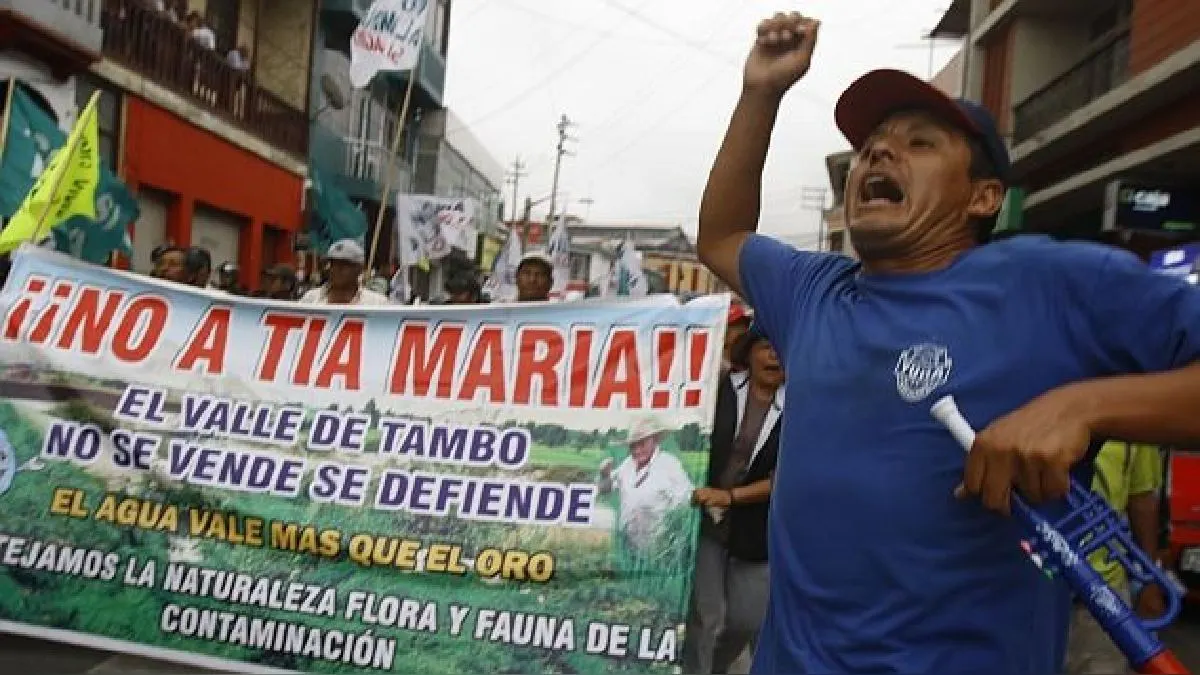Peru: The fight against mining projects opens up a new perspective

The resumption of conflicts against big mining, in response to the government’s decision to go forward with projects widely rejected by the people, such as Conga or Tia Maria, opens up the possibility of dealing a defeat to Boluarte and company in the field of class struggle and modifying the correlation of forces in favor of the working class and the poor.
By Víctor Montes
In response to the demands of the big mining companies, and in search of their support, the government of Dina Boluarte has declared to the four winds its decision to “unblock” the mining investment portfolio, beginning by reactivating widely repudiated mining projects, such as the gold mining project “Conga” (Cajamarca Region) or the Tia Maria copper mining project (Arequipa Region), and with this to take advantage of the context of the rise in the price of copper.
This call is a declaration of war against the communities that have been confronting mining exploitation in the headwaters of the river basins and near valleys of important agricultural production, such as the Tambo Valley in Arequipa.
For this reason, these same communities, organized in their defense, have come out to respond without delay to the government’s declarations, announcing their willingness to immediately take up the fight (1).
Cajamarca at the front: Colpayoc no va!
Cajamarca has a long tradition of struggle against the mining industry. Since 1992, when the Fujimori dictatorship granted the concession for the current Yanacocha gold mine (the most important in the country), the communities affected by water pollution began to mobilize and became a reference point in this struggle.
It is not surprising, then, that it is precisely the people of Cajamarca who immediately came out to repudiate the government’s declarations and to confront the mining companies.
On June 10, thousands of community members from the district of Chetilla (province of Cajamarca), residents of different areas surrounding the Colpayoc gold mining project, mobilized to the area where the mining company is carrying out exploration activities (Cerro Colpayoc, in the hamlet of Majadaspampa), attempting to burn the machinery used for excavations to determine the quality of the ore in the area. In April, a similar mobilization had already confronted those carrying out exploration operations.
The communities of the Chetilla district denounce that the project is located at the headwaters of the Ronquillo, Chonta and Cushunga river basins. These in turn are related to the Mashcón River and then to the Cajarmarquino River. For this reason, the project will contaminate their main water sources, as has happened with the Grande River, which feeds acidic waters to the historic city of Cajamarca.
The community members remain in a state of struggle. As a result, the defense fronts of the districts of Chetilla, Ronquillo and Cajamarca made a public statement in repudiation of the Minister of Energy and Mines, Rómulo Mucho, who announced his arrival in Cajamarca to “promote mining projects” last June 21, and whom they declared to be the ‘enemy of sustainable development’.
Recalling the slogan that led the struggle of the people of Cajamarca against the Conga mining project during the government of Ollanta Humala (“Conga no va!”), the community members of Chetillo have raised their voices loudly, Colpayoc no va!
The Tambo Valley returns to the struggle
For their part, the people of the Tambo Valley quickly held a massive assembly with delegations of farmers, merchants and citizens in general from the districts of Cocachacra, Punta de Bombón, Dean Valdivia and Mollendo, in which they decided to restart their struggle and planned an action for July 19.
The Tambo Valley struggle dates back to 2009 and is one of the symbols of the struggle against dispossession by large mining companies. With its recurrent action, the population of the Tambo Valley has repeatedly repelled the attempts of successive governments (Alan Garcia, Ollanta Humala, Pedro Pablo Kuzsynski and Vizcarra) to pass the project owned by the transnational Southern Peru Cooper Corporation, which has been operating in Peru since the late 1950s.
The possibility of the restart of the people’s actions could become the litmus test of Boluarte’s murderous government. Every time a government has tried to push forward Tia Maria, it has been met with fierce resistance from the people of the Tambo Valley and has had to back down.
What should we, as workers, do?
For all the workers of the country, the resumption of the mining conflicts and the possibility that these will defeat the Boluarte government’s attempt to surrender the country’s resources, opens an enormous possibility to change the dynamics of the class struggle, which after the ferocious repression with which the government imposed itself at the beginning of 2023, savagely assassinating 49 fighters, has suffered a clear setback.
We workers must, therefore, support in solidarity and actively put ourselves behind this struggle and mobilize against the repression that the government may unleash in Cajamarca, Arequipa, and wherever it intends to impose the plundering of our resources.
However, the mobilization cannot be organized just around solidarity. The struggle of the peasant and indigenous communities against mining exploitation has a powerful background: the struggle against the imperialist domination of our resources, protected by the neoliberal economic model, and the struggle against the destruction of the ecosystems that allow their subsistence. Therefore, for the working class, these struggles pose the enormous challenge of taking up the banners of the affected populations, peasants and indigenous, as our own and fight side by side. We must begin by demanding unrestricted respect for prior consultation, of a binding nature, for the communities that will be affected by the mining, oil and forestry action.
Only from this position is it possible for the working class to become the leadership of the whole process in order to direct it towards the only fundamental solution with which we can guarantee the demands of these same communities: to form a government of the workers, peasants, indigenous peoples and all poor people.
As we have already said, the struggle of the peoples against mining is the expression of the struggle of the people against imperialist plunder that only leaves misery and the destruction of the environment, which makes it impossible for the peasant and indigenous communities to resume their fundamental economic activity once mining extraction is concluded.
Therefore, fundamentally, both the communities that oppose the start of new mining projects, especially those that affect agricultural production, and the workers and poor people of the city, face the same enemy. An enemy that has in the government of Dina Boluarte its main agent, ready to impose with blood and fire the continuity of the plundering of our resources.
For this reason, together with the stoppage of the mining projects in question, it is essential to fight for the expropriation without payment of the mining companies that are already operating, to put them under the control of their workers, and thus, hand in hand with the communities, put these resources at their service and plan the mitigation of the impact of mining activities. It is therefore essential that together with the demands of the working class and the struggle against the reactionary advance of the laws passed by Congress, the struggle against the beginning of the Tia Maria project, the struggle against exploration in Colpayoc, against Michiquillay and the Conga project, become a national struggle, of all the country’s workers, for the defeat of Boluarte, Congress, and against imperialism.
Notes
- Organizations of a united front in which diverse popular organizations build their platforms of demands to mobilize in a unitary way. In Peru they have a history of between 40 and 50 years. ︎




